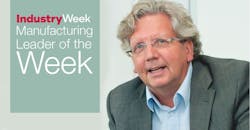AkzoNobel: Sustainability is a Profitable Business Model
The issue at hand for AkzoNobel was how to drive both energy and resource efficiencies in their operations.
Five years ago 30% of the company’s energy resources were renewable but they wanted to increase that number to 45% across the globe by 2025. Currently, they are at 40% with almost half the company’s sites around the world having improved their energy footprint in 2016
“Over past few years we created partnerships between business and the public sector to increase our share of wind, solar and biobased energy in our operations,” explains André Veneman, corporate director of Sustainability at AkzoNobel, the Dutch manufacturer of yacht paints and coating brands International and Awlgrip.
AkzoNobel is involved in several ongoing sustainability partnerships, notably in the Netherlands. These include sourcing energy from two new wind parks, switching from gas to sustainably generated steam to provide energy for chemicals production and investigating the possible launch of a waste-to-chemicals factory.
What the company discovered was that as they became more sustainable in their energy choices it brought forward “new horizons for business,” Veneman said.
“We began thinking about how to source abundant energy, and discovered that we can use the excess energy for further production.” While the intention was to cut costs and find renewable sources, the company ended up being part of an overall solution to energy issues. “We can become the industry to build a new tech platform and therefore be less vulnerable to changes in fossil fuel. We can become part of the solution of stabilizing the energy grid using new technologies.”
All of this did not happen by chance. Veneman explains that when looking at resources companies pass through a variety of levels. The first is by beginning to use a little solar energy and small amounts of biomass throughout operations. Phase two is to create a strong sustainable program across the enterprise. At the third level, the company has truly integrated sustainability so that it moves to procurement, marketing and sales. On the fourth level sustainability will contribute to business transformation that moves into changing the company’s product mix based on sustainability criteria. And at the fifth level, the company begins helping customers take this route through new solutions.
“At these highest level companies focus on how business is having a social impact,” says Veneman. “It’s not really a moral obligation but a way to transform business while meeting sustainability goals.”
The company has been among the global leaders in sustainability for more than a decade, with its moto “sustainability is business and business is sustainability.”
The motto is at the core of the company’s Planet Possible sustainability agenda. The agenda is summed up by the company’s explanation of what the agenda means. “When people ask us what sustainability means to AkzoNobel, we tell them that our success depends on it.”
This strategy is driving the company to set even high goals past the 2025 timeline.
“Our ambition to eliminate carbon emissions and use 100% renewable energy by 2050 demonstrates our clear and unwavering commitment to sustainability,” CEO Ton Büchner said in a recent announcement.
In tandem with moving toward towards zero carbon emissions, is the company's objective to create innovative products and services that help their customers both reduce energy use and carbon impact. The company desires to be on the “forefront of industry efforts to transform the use of resources throughout the value chain.”
hey plan to achieve this goal by “ understanding the expectations of the end market”, Veneman says. In fact, more than 80% of the companies R&D efforts focus on new product solutions. Veneman gives the example in the decorative coating market where customers look for products that don't create indoor air pollution. So the company is increasing its share of water based coatings. “Our stakeholders are asking for improvement. For example, last year in China a tax was imposed on solvent based coatings.”
Veneman sees these restrictions and other customer preferences as opportunities. “Our Planet Possible is an optimistic approach, never doom and gloom. Across the world, we can use our excellent brains, skills, and cooperation to solve the issues and provide plenty of business opportunities at the same time.”
The IndustryWeek Manufacturing Leader of the Week highlights the manufacturing leaders, executives and stars who are driving growth in today's industry and helping to shape the future of manufacturing.
